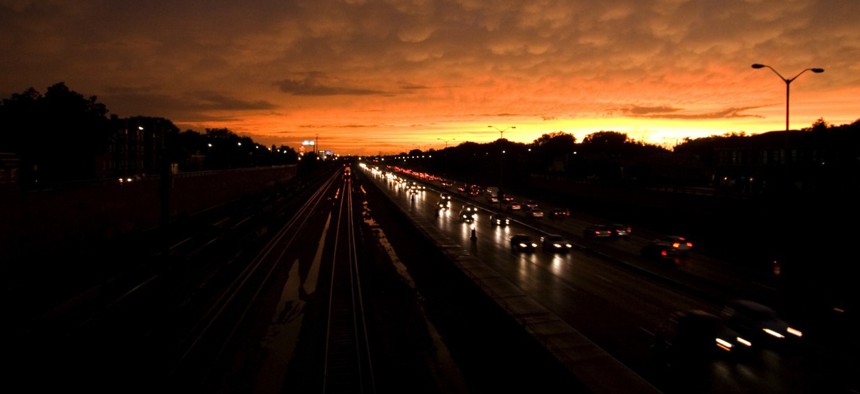Dissecting One Community’s Digital Outreach on a Major Infrastructure Project

The Eisenhower Expressway passes through Oak Park, Illinois Ben Husmann / Flickr via CC BY 2.0
Rebuilding the Eisenhower Expressway through Oak Park, Illinois, will be a major undertaking. Here’s how this Chicago suburb is informing its residents of the planning process and what’s to come.
OAK PARK, Ill. — Driving from Chicago into this neighboring suburb along the Eisenhower Expressway early afternoon on Friday, I experienced first hand one of the most annoying traffic choke points in a region full of annoying traffic choke points.
On-ramps and off-ramps for Oak Park’s two interchanges, Austin Boulevard and Harlem Avenue, are on the left instead of on the right as is the norm along the “Ike,” and most U.S. expressways. So Eisenhower Expressway commuters heading to and from Oak Park have to navigate the faster-moving travel lanes. And drivers unfamiliar with Oak Park’s left-side exits—like me—can be easily caught off-guard and have to quickly move from the right side of the travel lanes to the left.
As a result of the left-side on-ramps and off-ramps, traffic moving through Oak Park on the Ike, formally designated as Interstate 290, can often be sluggish, even outside of the peak travel times.
And it can be dangerous. As I was trying to move from the right-most lane toward the left-side exit for Harlem Avenue, a faster-moving SUV was trying to merge into the lane I was in from the left. Fortunately, there’s wasn’t an accident, but it was close.
The Illinois Department of Transportation has long-range plans to upgrade the Ike , where the expressway’s right of way also accommodates the Chicago Transit Authority’s Blue Line rail tracks, and in Oak Park, three of its stations.
Various options are under consideration to improve the Ike, including expansion to create a high-occupancy lane or managed tolled lane in either direction—but realigning Oak Park’s left-side exits to the right side of the expressway is a priority under all of them.
So are noise-abatement walls. Like many expressways built through urbanized areas, the Ike is a major gash through the southern portion of Oak Park, a village with roughly 50,000 residents, best known for its collection of Frank Lloyd Wright’s early commissions and the famous architect’s home and studio. Those living adjacent to the expressway’s right of way endure higher decibel noise from the constant traffic.
Although IDOT is nearing a preferred alternative for the Ike, funding is not in place. So it’s very much unclear when the state will move forward on construction.
In the meantime, village leaders want residents to be informed about the planning process so when construction starts, they won’t be caught off guard.

Near the entrance of Oak Park’s Village Hall, there are 3-D models of the proposed realigned interchanges in Oak Park. It’s certainly a nice visual tool to give residents an idea of what might be coming. But physical models displayed in a public space have limited utility.
The village’s website offers a robust trove of materials related to the project that can answer pretty much any question—except how the state is going to fund the new and improved Ike.
But there's a detailed backgrounder on the noise walls , one of the major local features of the project. One of the frequently asked questions is: “How is the height of the barrier determined?”
Noise walls are designed to provide a minimum of five decibels of reduction in average background traffic noise for the majority of first row of residences located directly behind the wall, with a seven-decibel reduction in at least one location. The design goal for a sound barrier is a 10-decibel reduction. The reasonableness criterion places a practical limitation on the height of any noise barrier.
Included in Oak Park’s “Eye on the Ike” document library, there’s an air quality sensitivity analysis , noise wall renderings , diagrams of the properties eligible to vote on the noise walls (a section is below).

There’s also an archive of official presentations made to the community and correspondence between the village government and IDOT .
Often times with major infrastructure projects, local residents start asking questions only when construction begins and at points when time has passed for their input to be considered.
While a state agency is in charge of a project that will have major local impacts, the village government has played an active role to manage the communication and engagement between Oak Park residents and decisionmakers at IDOT.
And with that, effective digital management at the local level has been essential. Any community dealing with a similar type of multi-year planning and construction project should look to Oak Park as a local government that has put digital communication front and center.
Michael Grass is Executive Editor of Government Executive’s Route Fifty.
NEXT STORY: Why Launching a New Website Is Only Half the Battle for Local Governments






